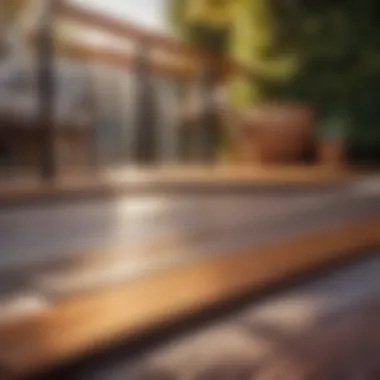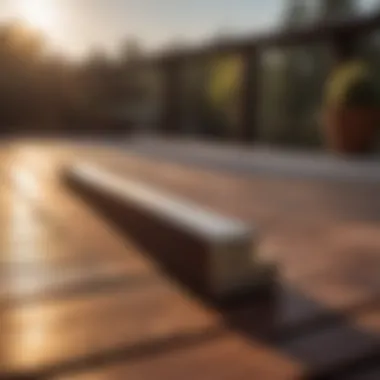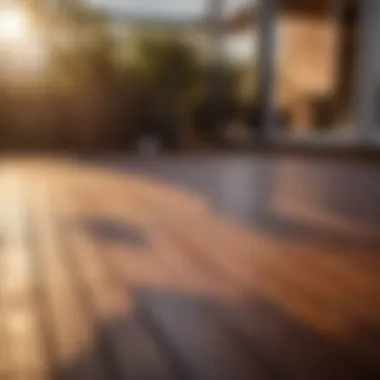Materials:
- Composite Deck Boards: 10 pieces of Trex Enhance Basics Composite Decking Boards, each measuring 1 inch x 6 inches x 12 feet.
- Deck Substructure: Pressure-treated wood joists, 4 inches x 4 inches, measuring the same length as the decking boards.
- Hidden Fasteners: Stainless steel clips and screws for a seamless finish.
- Composite Deck Screws: 2.5-inch stainless steel screws for securing deck boards.
- Composite Deck Cleaner: Biodegradable cleaner specifically formulated for composite materials.
DIY Steps:
- Begin by measuring and outlining the deck area where you intend to install the composite decking.
- Prepare the deck substructure by ensuring it is level and securely anchored to the ground.
- Install the pressure-treated wood joists perpendicular to the house, spaced approximately 16 inches apart.
- Start laying the composite deck boards from one end, ensuring equal spacing between each board.
- Use hidden fasteners to attach the boards for a clean and polished appearance.
- Secure the deck boards with stainless steel screws, making sure they are flush with the surface.
- Apply the composite deck cleaner according to the manufacturer's instructions to maintain the decking's appearance.
Technical Aspects:
- Tools Required: Tape measure, circular saw, drill/driver, hammer, level, and rubber mallet.
- Timing Specifics: Allow 2-3 days for the complete installation of the composite decking, including substructure preparation.
- Critical Techniques: Ensure the deck substructure is sturdy and level to prevent sagging or uneven decking. Use precise measurements when cutting and installing boards for a professional finish.
DIY Project Process:


- Sequential Steps: Begin by setting up the deck frame, followed by attaching the joists and laying the composite deck boards systematically.
- Troubleshooting Tips: If boards are not aligning correctly, ensure the joists are properly spaced and adjust accordingly. In case of uneven gaps, recheck measurements and make adjustments as needed.
Introduction


Composite decking materials have revolutionized outdoor living spaces, offering a range of benefits and options for homeowners aiming to elevate their decks. This comprehensive guide aims to delve deep into exploring the world of composite decking, providing readers with valuable insights into the various material options available, installation considerations, and maintenance tips to ensure a well-informed decision-making process.
Understanding Composite Decking
Composite decking refers to a versatile material composed of a blend of wood fibers, plastics, and other additives. This unique blend results in a durable and low-maintenance decking option that replicates the look and feel of traditional wood without the inherent drawbacks. The key characteristic of composite decking lies in its weather-resistant properties, making it an ideal choice for outdoor applications. Despite being initially more expensive than wood, the long-term advantages, such as minimal maintenance and longevity, position composite decking as a popular choice for modern homeowners.
Definition of Composite Decking
Composite decking stands out due to its composite nature, combining the best qualities of wood and plastic to create a durable and aesthetically pleasing deck material. Its unique feature lies in the fact that it is resistant to rot, mold, and fading, eliminating the need for staining or sealing. This aspect significantly reduces the maintenance efforts required, making it an attractive option for those seeking a low-maintenance outdoor decking solution.
Advantages of Composite Materials
The advantages of composite materials are vast, ranging from their eco-friendly composition to their long-lasting durability. Composite decking materials are composed of recycled materials, making them a sustainable choice for environmentally-conscious consumers. Additionally, they boast impressive resistance to staining, scratching, and fading, ensuring that the deck retains its aesthetic appeal for years to come. While the upfront cost of composite decking may be higher than traditional wood, the long-term savings in maintenance and replacement costs make it a cost-effective investment in the long run.
Importance of Choosing the Right Material
Selecting the appropriate composite decking material is crucial for ensuring the longevity and aesthetics of your outdoor space. Factors such as durability and design options play a key role in determining the right fit for your decking project.
Durability Factors
Durability is a critical aspect to consider when choosing a decking material, especially for outdoor applications where exposure to the elements is constant. Composite decking excels in terms of durability, as it is resistant to rot, insect infestation, and warping, ensuring a long lifespan for your deck. This characteristic makes composite decking a practical and reliable choice for outdoor decking projects.
Aesthetics and Design Options
Apart from durability, the aesthetics and design options offered by composite decking materials are unmatched. With a wide range of colors, textures, and finishes available, homeowners can customize their outdoor space to reflect their unique style and preferences. Additionally, composite decking allows for creative design elements such as intricate patterns and inlays, enhancing the visual appeal of the deck. The versatility of composite materials in terms of design opens up a world of possibilities for creating a personalized and inviting outdoor living area.
Types of Composite Decking Materials


Wood-Plastic Composite (WPC)
Wood-Plastic Composite (WPC) stands out as a popular choice among composite decking materials due to its innovative composition and features. The blend of wood fibers and recycled plastic in WPC creates a durable and environmentally friendly decking option that combines the natural look of wood with the low maintenance of plastic.
Composition and Features
The composition of WPC, comprising a mix of wood fibers and plastic polymers, provides a sturdy and resilient material that mimics the appearance of traditional wood decks while offering superior durability and resistance to rot, decay, and insects. This unique fusion of natural and synthetic components ensures a long-lasting and aesthetically pleasing decking solution.
Pros and Cons
The pros of WPC decking include its eco-friendly nature, low maintenance requirements, resistance to moisture, and versatility in design and color options. However, potential cons may include susceptibility to mold in damp conditions and a slightly higher initial cost compared to traditional wood decking.
Capped Composite Decking
Capped composite decking presents another compelling option for homeowners seeking a high-performance and low-maintenance outdoor flooring solution. The addition of a protective polymer cap to the composite core enhances the durability, longevity, and aesthetics of the decking.
Protective Layer Benefits
The protective layer in capped composite decking offers significant benefits by shielding the core materials from moisture, UV rays, stains, and scratches, thereby ensuring a resilient and long-lasting surface. This added layer of protection contributes to the overall stability and longevity of the deck structure.
Longevity and Maintenance
One of the key advantages of capped composite decking is its exceptional durability and minimal maintenance requirements. The encapsulated design prevents moisture penetration, mold growth, and color fading, translating into a low-maintenance and visually appealing decking solution that withstands the elements.
PVC Composite Decking
PVC composite decking entails a distinctive construction that sets it apart from other composite materials, making it a sought-after choice for homeowners prioritizing durability and ease of maintenance.
Characteristics and Advantages
The inherent characteristics of PVC composite decking, such as its lightweight structure, high resistance to moisture and heat, and ease of installation, make it an attractive option for outdoor flooring projects. Additionally, PVC decking boasts exceptional color retention and is resistant to fading, staining, and scratching.
Considerations for Installation
When considering the installation of PVC composite decking, factors such as ease of installation, compatibility with different substructures, and thermal expansion properties come into play. Understanding these considerations is vital for ensuring a seamless and structurally sound installation that maximizes the benefits of PVC decking.
Factors to Consider When Choosing Composite Decking
When delving into the realm of composite decking materials, one must carefully consider various factors to ensure an optimal choice for their outdoor living space. Understanding the importance of selecting the right composite decking material is paramount in achieving a durable, aesthetically pleasing, and long-lasting deck. This section aims to shed light on key elements that homeowners need to ponder before making a decision.
Budget and Cost Analysis
Initial Investment vs. Long-Term Savings: In the realm of composite decking, the dichotomy between initial investment and long-term savings plays a pivotal role in decision-making. Homeowners need to weigh the upfront cost of purchasing and installing composite decking against the long-term benefits it offers, such as minimal maintenance requirements, longevity, and durability. By opting for composite decking that may have a higher initial cost but provides significant savings over its lifespan due to reduced maintenance, repairs, and replacements, homeowners can make a prudent financial choice that pays off in the long run. Understanding the unique selling point of composite decking's long-term savings potential empowers homeowners to make an informed decision that aligns with their budget and financial objectives.
Comparing Prices Across Materials: Another critical aspect to consider when choosing composite decking is comparing prices across different materials available in the market. Homeowners need to conduct thorough research on the pricing variations of various composite decking options to find the most cost-effective yet quality solution for their outdoor space. By evaluating price points based on factors like material composition, brand reputation, warranties, and maintenance requirements, homeowners can pinpoint the composite decking material that offers the best value for their investment. Understanding the nuances of price comparison aids in making a well-informed decision that balances quality, affordability, and long-term cost-effectiveness.
Environmental Impact
Sustainability Practices: With a growing emphasis on sustainable living practices, the eco-conscious homeowner values the sustainability practices employed in manufacturing composite decking materials. Opting for composite decking that prioritizes sustainable sourcing, recycling initiatives, and eco-friendly production processes ensures a reduced environmental footprint. By choosing decking materials crafted with sustainable practices, homeowners contribute to conservation efforts and promote environmentally responsible choices in their outdoor projects. Understanding the significance of sustainability practices in composite decking empowers individuals to make environmentally conscious decisions that align with their values.
Recyclability: Another pivotal consideration in the environmental impact of composite decking is the recyclability factor. Homeowners focused on reducing waste and promoting circular economy principles favor decking materials that are recyclable at the end of their lifespan. Composite decking that can be recycled into new products or reused in other applications demonstrates a commitment to environmental stewardship and resource conservation. By acknowledging the recyclability of decking materials, homeowners actively participate in creating a sustainable cycle of materials usage that minimizes waste and maximizes resource efficiency.
Installation and Maintenance Tips
Installation Process Overview
Preparation Steps:
Exploring the specific aspect of preparation steps is fundamental to the successful installation of a composite deck. Prior to laying down the decking materials, thorough preparation of the installation site is necessary. This includes assessing the ground for stability, ensuring proper drainage, and clearing the area of any debris or obstacles. One key characteristic of effective preparation steps is meticulous planning, which helps prevent future issues such as uneven decking or water pooling. This detailed preparation stage is a popular choice for this article as it sets the foundation for a durable and well-constructed composite deck. The unique feature of thorough preparation steps lies in its ability to enhance the structural integrity and overall performance of the deck, ultimately leading to increased customer satisfaction and long-term investment value.
Best Practices:
Discussing the best practices for composite deck installation is essential for achieving a professional and visually pleasing result. Emphasizing the importance of using high-quality fasteners, following manufacturer guidelines, and maintaining proper ventilation during installation are key characteristics of best practices in decking. By adhering to these best practices, homeowners can ensure a smooth and efficient installation process that minimizes potential issues and maximizes the durability of the deck. The unique feature of recommended best practices is their ability to streamline the installation process, minimize the risk of errors, and contribute to the overall quality and longevity of the composite deck. Implementing best practices in deck installation not only enhances the aesthetic appeal of the outdoor space but also emphasizes the structural integrity and safety of the deck.
Maintenance Guidelines
Cleaning and Stain Removal:
Effective cleaning and stain removal techniques are essential for preserving the appearance and functionality of a composite deck. Utilizing gentle cleaning solutions, avoiding harsh chemicals, and using soft bristle brushes can help remove dirt, debris, and stains without damaging the deck surface. This key characteristic of cleaning and stain removal promotes the longevity and aesthetic appeal of the deck by keeping it clean and free from blemishes. The unique feature of implementing proper cleaning and stain removal methods is the ability to maintain the deck's original beauty and color, ensuring a vibrant and inviting outdoor space for relaxation and entertaining. By following recommended cleaning practices, homeowners can enjoy a pristine deck that enhances their outdoor living experience.
Preventative Care:
Discussing preventative care measures is essential for ensuring the long-term durability and appearance of a composite deck. Regular inspections, proactive maintenance, and protective measures such as applying sealant can significantly extend the lifespan of the deck. The key characteristic of preventative care is its proactive approach to deck maintenance, which helps prevent issues such as mold growth, fading, and structural damage. The unique feature of preventative care lies in its ability to safeguard the deck against environmental factors and everyday wear and tear, ensuring a resilient and attractive outdoor space. By incorporating preventative care practices into their maintenance routine, homeowners can protect their investment and enjoy a well-maintained composite deck for years to come.
Conclusion
In the vast landscape of composite decking materials, the 'Conclusion' section plays a pivotal role in summarizing key takeaways and guiding homeowners towards optimal choices for their outdoor spaces. One crucial aspect highlighted here is the significance of meticulous planning and selection when embarking on a decking project. By encapsulating insights from earlier sections on material types, installation factors, and maintenance essentials, the 'Conclusion' serves as a beacon of wisdom for readers.
It outlines the importance of understanding the durability elements and aesthetic nuances of various composite materials. Moreover, it emphasizes the long-term benefits of investing in high-quality decking that aligns with both personal preferences and practicality. This encapsulation aids homeowners in making informed decisions, ensuring that their outdoor sanctuaries are not only stylish but also enduring in the face of environmental challenges.
Final Considerations
Choosing the Right Fit
The process of 'Choosing the Right Fit' is a critical component in the realm of composite decking, bridging the gap between vision and implementation seamlessly. This aspect revolves around selecting a material that harmonizes with the overall design scheme, budget constraints, and performance expectations. A key characteristic of 'Choosing the Right Fit' lies in its ability to strike a balance between aesthetics and functionality, catering to the diverse needs of homeowners.
The unique feature of 'Choosing the Right Fit' is its adaptability to various settings and preferences, ensuring a tailored solution for every outdoor space. While the advantages include personalized design options and natural appeal, considerations such as ongoing maintenance and weather resistance should be factored in. Overall, 'Choosing the Right Fit' remains a popular choice for homeowners seeking a blend of style, durability, and customization in their decking projects.
Enhancing Outdoor Living Spaces
The concept of 'Enhancing Outdoor Living Spaces' transcends mere aesthetics, encompassing a holistic approach to creating havens of relaxation and rejuvenation. This element underscores the transformative power of well-designed decks in elevating the overall quality of life for homeowners. A key characteristic of 'Enhancing Outdoor Living Spaces' is its ability to extend the indoor living experience beyond conventional boundaries, fostering a seamless connection with nature.
The unique feature of 'Enhancing Outdoor Living Spaces' lies in its ability to create versatile zones for social gatherings, solitary retreats, and family activities, enhancing the functionality of outdoor areas. While the benefits include increased property value and expanded living space, considerations such as climate impacts and maintenance efforts should be evaluated. Ultimately, 'Enhancing Outdoor Living Spaces' enriches the homeowner's lifestyle, turning ordinary yards into extraordinary retreats.





